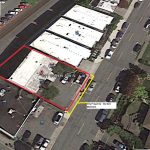Is There Water Damage at Your Business? Here’s A 5-Step Walkthrough to Find Out.

Water leaking from the roof, a slow drip under a sink – some signs of water problems are obvious. But it doesn’t take much water to cause significant damage to a building, and sometimes issues go unnoticed until they create a big problem. Commercial properties, which often have more bathrooms and sinks than residential properties, have even more plumbing to keep an eye on.
If you’re a business or property owner, follow these steps to find any lurking problems before they become big headaches:
 Start with bathrooms and kitchens/break rooms. Check water lines behind toilets and under sinks for drips, and note any water marks in cabinets under sinks. Dishwashers, washing machines, and fridges with built-in icemakers also all use water, so don’t forget to check those plumbing connections. If you have a multi-level building, check the ceiling of the room under all of your fixtures. A discolored area ringed in brown is a telltale sign of a leak, and small black spots indicate mold growth.
Start with bathrooms and kitchens/break rooms. Check water lines behind toilets and under sinks for drips, and note any water marks in cabinets under sinks. Dishwashers, washing machines, and fridges with built-in icemakers also all use water, so don’t forget to check those plumbing connections. If you have a multi-level building, check the ceiling of the room under all of your fixtures. A discolored area ringed in brown is a telltale sign of a leak, and small black spots indicate mold growth.- Check floors and walls. A leaky roof doesn’t only present itself as a dripping ceiling, and water may seem down walls and across floors. Try to walk around inside your property with no shoes on, and feel the walls with your hands as you walk. Drywall often develops a chalky texture when wet. Wood surfaces (in floors, moulding, etc), will feel soft or spongey. Also note any discoloration, strange bubbling, or peeling under wallpaper or other wall coverings. And obviously, any carpeted areas that feel squishy or damp are huge red flags.
- Keep an eye on your foundation. It’s a place that often gets overlooked when you’re just worried about a leaky roof, but water damage can also come from below. Check your foundation and any basements or garages for water damage. Water leaks in this area will usually present as a white residue.
 Trust your senses. After you look everything over, give your other senses a try. If you often use air fresheners or scented cleaning products in your building, go without them for a short period. Any musty, moldy, or other strange smells? Next, try turning off any music, fans, or other noise-producing objects. Sounds that might be drowned out by everyday noise may be obvious in a quiet room. Any dripping or rushing noises? Finally, examine your health. Do you seem to sneeze, cough, or have watery eyes more often than normal when you’re at this property? Have your employees or tenants ever reported higher-than-average cases of allergies or respiratory illness? These can be signs of mold.
Trust your senses. After you look everything over, give your other senses a try. If you often use air fresheners or scented cleaning products in your building, go without them for a short period. Any musty, moldy, or other strange smells? Next, try turning off any music, fans, or other noise-producing objects. Sounds that might be drowned out by everyday noise may be obvious in a quiet room. Any dripping or rushing noises? Finally, examine your health. Do you seem to sneeze, cough, or have watery eyes more often than normal when you’re at this property? Have your employees or tenants ever reported higher-than-average cases of allergies or respiratory illness? These can be signs of mold.- Checkout outside as well as in. Turn on the water and look over your sprinkler or irrigation system. Any clogged or broken sprinkler heads, leaks, or pooling water?
With an occasional walkthrough and a keen eye, you’ll head off any water issues before you end up with a costly water damage problem.
Recent Posts






